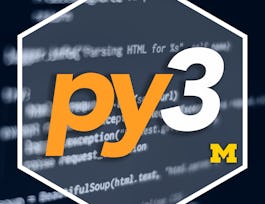Analyzing data with Python is an essential skill for Data Scientists and Data Analysts. This course will take you from the basics of data analysis with Python to building and evaluating data models.

Offrez à votre carrière le cadeau de Coursera Plus avec $160 de réduction, facturé annuellement. Économisez aujourd’hui.


Data Analysis with Python
Ce cours fait partie de plusieurs programmes.

Instructeur : Joseph Santarcangelo
484 795 déjà inscrits
Inclus avec 
(18,518 avis)
Expérience recommandée
Ce que vous apprendrez
Develop Python code for cleaning and preparing data for analysis - including handling missing values, formatting, normalizing, and binning data
Perform exploratory data analysis and apply analytical techniques to real-word datasets using libraries such as Pandas, Numpy and Scipy
Manipulate data using dataframes, summarize data, understand data distribution, perform correlation and create data pipelines
Build and evaluate regression models using machine learning scikit-learn library and use them for prediction and decision making
Compétences que vous acquerrez
- Catégorie : Model Selection
- Catégorie : Data Analysis
- Catégorie : Python Programming
- Catégorie : Data Visualization
- Catégorie : Predictive Modelling
Détails à connaître

Ajouter à votre profil LinkedIn
11 devoirs
Découvrez comment les employés des entreprises prestigieuses maîtrisent des compétences recherchées

Élaborez votre expertise du sujet
- Apprenez de nouveaux concepts auprès d'experts du secteur
- Acquérez une compréhension de base d'un sujet ou d'un outil
- Développez des compétences professionnelles avec des projets pratiques
- Obtenez un certificat professionnel partageable


Obtenez un certificat professionnel
Ajoutez cette qualification à votre profil LinkedIn ou à votre CV
Partagez-le sur les réseaux sociaux et dans votre évaluation de performance

Il y a 6 modules dans ce cours
In this module, you will learn how to understand data and learn about how to use the libraries in Python to help you import data from multiple sources. You will then learn how to perform some basic tasks to start exploring and analyzing the imported data set.
Inclus
6 vidéos1 lecture2 devoirs2 éléments d'application2 plugins
In this module, you will learn how to perform some fundamental data wrangling tasks that, together, form the pre-processing phase of data analysis. These tasks include handling missing values in data, formatting data to standardize it and make it consistent, normalizing data, grouping data values into bins, and converting categorical variables into numerical quantitative variables.
Inclus
6 vidéos1 lecture2 devoirs2 éléments d'application1 plugin
In this module, you will learn what is meant by exploratory data analysis, and you will learn how to perform computations on the data to calculate basic descriptive statistical information, such as mean, median, mode, and quartile values, and use that information to better understand the distribution of the data. You will learn about putting your data into groups to help you visualize the data better, you will learn how to use the Pearson correlation method to compare two continuous numerical variables, and you will learn how to use the Chi-square test to find the association between two categorical variables and how to interpret them.
Inclus
5 vidéos1 lecture2 devoirs2 éléments d'application3 plugins
In this module, you will learn how to define the explanatory variable and the response variable and understand the differences between the simple linear regression and multiple linear regression models. You will learn how to evaluate a model using visualization and learn about polynomial regression and pipelines. You will also learn how to interpret and use the R-squared and the mean square error measures to perform in-sample evaluations to numerically evaluate our model. And lastly, you will learn about prediction and decision making when determining if our model is correct.
Inclus
6 vidéos1 lecture2 devoirs2 éléments d'application1 plugin
In this module, you will learn about the importance of model evaluation and discuss different data model refinement techniques. You will learn about model selection and how to identify overfitting and underfitting in a predictive model. You will also learn about using Ridge Regression to regularize and reduce standard errors to prevent overfitting a regression model and how to use the Grid Search method to tune the hyperparameters of an estimator.
Inclus
4 vidéos1 lecture2 devoirs2 éléments d'application2 plugins
Congratulations! You have now completed all the modules for this course. In this last module, you will complete the final assignment that will be graded by your peers. In this final assignment, you will assume the role of a Data Analyst working at a real estate investment trust organization who wants to start investing in residential real estate. You will be given a dataset containing detailed information about house prices in the region based on a number of property features, and it will be your job to analyze and predict the market price of houses given that information.
Inclus
5 lectures1 devoir1 évaluation par les pairs2 éléments d'application1 plugin
Instructeur

Offert par
Recommandé si vous êtes intéressé(e) par Data Analysis

The Hong Kong University of Science and Technology

University of Michigan

Università di Napoli Federico II

University of Colorado Boulder
Pour quelles raisons les étudiants sur Coursera nous choisissent-ils pour leur carrière ?




Avis des étudiants
Affichage de 3 sur 18518
18 518 avis
- 5 stars
76,12 %
- 4 stars
18,49 %
- 3 stars
3,68 %
- 2 stars
0,92 %
- 1 star
0,77 %

Ouvrez de nouvelles portes avec Coursera Plus
Accès illimité à plus de 7 000 cours de renommée internationale, à des projets pratiques et à des programmes de certificats reconnus sur le marché du travail, tous inclus dans votre abonnement
Faites progresser votre carrière avec un diplôme en ligne
Obtenez un diplôme auprès d’universités de renommée mondiale - 100 % en ligne
Rejoignez plus de 3 400 entreprises mondiales qui ont choisi Coursera pour les affaires
Améliorez les compétences de vos employés pour exceller dans l’économie numérique
Foire Aux Questions
Access to lectures and assignments depends on your type of enrollment. If you take a course in audit mode, you will be able to see most course materials for free. To access graded assignments and to earn a Certificate, you will need to purchase the Certificate experience, during or after your audit. If you don't see the audit option:
The course may not offer an audit option. You can try a Free Trial instead, or apply for Financial Aid.
The course may offer 'Full Course, No Certificate' instead. This option lets you see all course materials, submit required assessments, and get a final grade. This also means that you will not be able to purchase a Certificate experience.
When you enroll in the course, you get access to all of the courses in the Certificate, and you earn a certificate when you complete the work. Your electronic Certificate will be added to your Accomplishments page - from there, you can print your Certificate or add it to your LinkedIn profile. If you only want to read and view the course content, you can audit the course for free.
If you subscribed, you get a 7-day free trial during which you can cancel at no penalty. After that, we don’t give refunds, but you can cancel your subscription at any time. See our full refund policy.

